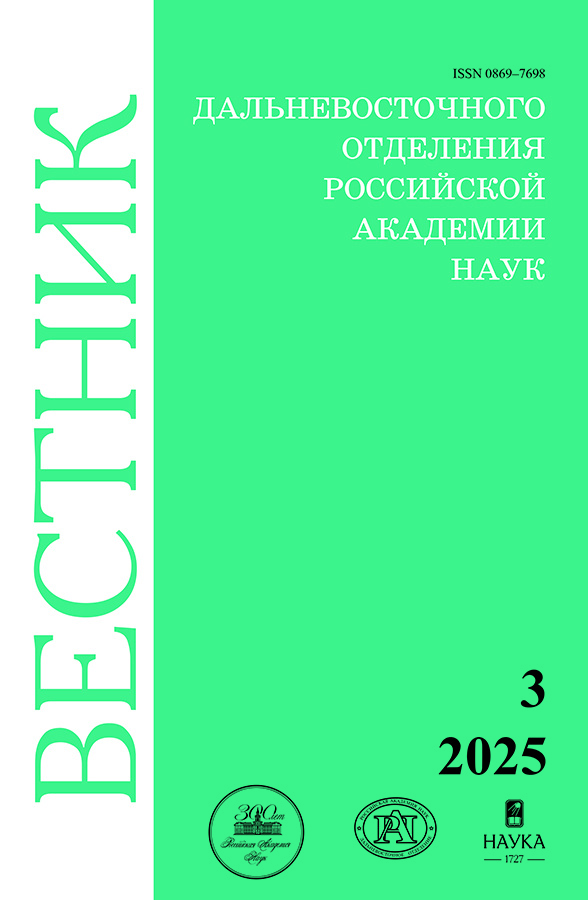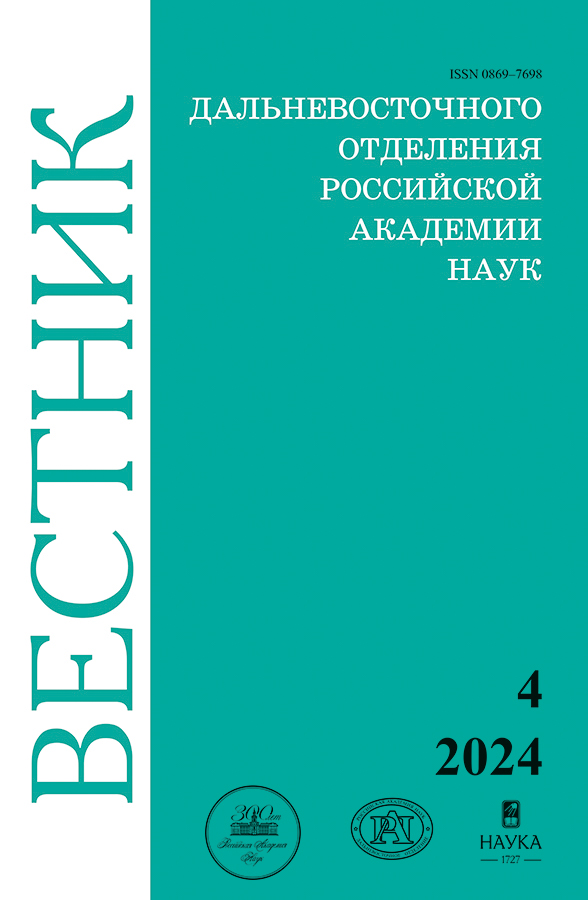Variability in the biochemical composition of a variety population of edible squash in generations of selection
- Authors: Bardina N.V.1, Pavlov D.A.2, Kim I.V.1
-
Affiliations:
- Federal Scientific Center of Agrobiotechnology of the Far East named after A. K. Chaika
- Far Eastern Federal University Federal Scientific Center of Agrobiotechnology of the Far East named after A. K. Chaika
- Issue: No 4 (2024)
- Pages: 119-125
- Section: Agricultural sciences. Crop science
- URL: https://permmedjournal.ru/0869-7698/article/view/676066
- DOI: https://doi.org/10.31857/S0869769824040099
- EDN: https://elibrary.ru/IQJTFY
- ID: 676066
Cite item
Full Text
Abstract
Our research revealed a stable one-way modification variation (weak) in “the content of sugars” in all variants of population F8, F9 (СV = 1.9–7.7%; 4.8–10.0%, uniformity – 98.1–92.3%; 95.2–90.0%, respectively). The content of carotene in F8 and F9 was most variable for the studied variants (CV = 20.0–60.0%; 14.7–30.0%, uniformity – 40.0–80.0; 70.0–85.3%, respectively). A moderate and significant variation in the content of vitamin C was characteristic of F8 (CV = 12.9–30.0, uniformity – 70.0–87.1%), a weak and moderate variation was observed in F9 (CV = 6.2–20.0%, uniformity – 80.0–93.8%). Variants F8, F9 had an ascorbic acid content of 14.2–21.7; 19.5–24.4 mg% accordingly, which exceeds the technological requirements imposed on varieties of edible squash for processing. Based on the evaluation of variation in the chemical parameters of fruit quality, by recurrent individual selection using the methods of halves, for the conservation of positive changes in variety population 945 and variants of necessary type, we selected seeds from the spare halves of variants F9 945-13, 945-27, 945-11, 945-12, 945-22, and 945-31 for further testing for economically important traits.
Full Text
About the authors
Natalia V. Bardina
Federal Scientific Center of Agrobiotechnology of the Far East named after A. K. Chaika
Author for correspondence.
Email: bardina1977@yandex.ru
ORCID iD: 0000-0001-6992-1666
Researcher
Russian Federation, Ussuriysk, Timiryazevsky stl.Dmitry A. Pavlov
Far Eastern Federal University Federal Scientific Center of Agrobiotechnology of the Far East named after A. K. Chaika
Email: pavlov1609@yandex.ru
ORCID iD: 0009-0007-2383-3709
Master’s Student
Russian Federation, Ussuriysk, Timiryazevsky stl.Irina V. Kim
Federal Scientific Center of Agrobiotechnology of the Far East named after A. K. Chaika
Email: kimira-80@mail.ru
ORCID iD: 0000-0002-0656-0645
Doctor of Sciences in Agriculture, Leading Researcher
Russian Federation, Ussuriysk, Timiryazevsky stl.References
- Khimich G. A., Korottseva I. B. Conveyor of varieties of pumpkin of Federal Research Vegetable Center (VNIISSOK) selection. Vegetable Crops of Russia. 2018;(1):63–65. (In Russ.).
- Kornilova M. S., Kurunina D. P., Varivoda G. V. Creation of competitive varieties of melon and pumpkin with valuable economic trends. Vegetable Crops of Russia. 2021;(6):36–41. (In Russ.).
- Golubkina N. A., Khimich G. A., Antoshkina M. S., Plotnikova U. D., Nadezhkin S. M., Korottseva I. B. Peculiarities of pumpkin carotenoid composition ‘Konfetka’ variety, prospects of utilization. Vegetable Crops of Russia. 2021;(1):111–116. (In Russ.).
- Kulyakina N. V., Kuz’mitskaya G.A., Shestopalova G. E. Bazilevich L. V., Selezneva N. N. Evaluation of biochemical characteristics of pumpkin in production of functional food products in the Far-Eastern region. Vegetable Crops of Russia. 2019;(2):63–69. (In Russ.).
- Tekhanovich G. A., Elatskova A. G., Elatskov Yu. A. Investigations by N. I. Vavilov and his influence on the promotion of introduction, collection study and breeding of cucurbitaceous crops. Vavilovia. 2019;2(2):44–57. (In Russ.).
- Kornilov A. S. Selektsiya i semenovodstvo ovoshchnykh kul’tur na yuge Dal’nego Vostoka. Vladivostok; 2008. 143 p. (In Russ.).
- Piskunova T. M., Mut’eva Z. F. The VIR collection – a source of initial breeding material for the perspective directions of breeding of a vegetable marrow and pumpkin. Vegetable Crops of Russia. 2016; 32(3):18–23. (In Russ.).
- Piskunova T. M., Gashkova I. V., Azhmukhamedova M. A. Mestnye sorta bakhchevykh kul’tur kak istochniki dlya selektsii na kachestvo ploda. In: Sovremennye tendentsii v selektsii i semenovodstve ovoshchnykh kul’tur. Traditsii i perspektivy: I Mezhdunar. nauch.-praktich. konf. = [Modern tendencies in the breeding and seed production of vegetable crops. Traditions and prospects: the 1st International scientific conference], August 4–6, 2008. Moscow: VNIISSOK; 2008. Vol. 2. P. 243–245. (In Russ.).
- Tarasenkov I. I. Selektsiya ovoshchnykh i bakhchevykh kul’tur vo VNIIO. In: Sbornik nauchnykh trudov po ovoshchevodstvu i bakhchevodstvu : k 75-letiyu VNIIO. T. 1: Selektsiya i semenovodstvo = [Collection of scientific papers on vegetable and melon growing dedicated to the 75th anniversary of the National Scientific Research Institute of Horticulture. Vol. 1: Breeding and seed production]. Moscow: Rossel’khozakademiya, VNIIO; 2006. P. 24–29. (In Russ.).
- Bykovskii Yu.A., Varivoda E. A., Malueva S. V., Nikulina T. M. Melons breeding for the south-east of Russia. Potato and Vegetables. 2017;(6):37–40. (In Russ.).
- Linda L. P., Karazhiya V. F., Sobaleva I. M. Sarandi T. A., Botnar’ O., Migalat’ev O. Pumpkin varieties and hybrids released in Moldova, suitable for processing. Vegetable Crops of Russia. 2012;(3):62–68. (In Russ.).
- Bunin M. S., Pivovarov V. F., Pavlov L. V. Polozhenie o proizvodstve semyan ehlity ovoshchnykh, bakhchevykh kul’tur, kormovykh korneplodov i kormovoi kapusty. Мoscow; 2008. 28 p. (In Russ.).
- Litvinov S. S. Metodika polevogo opyta v ovoshchevodstve. Moscow: Rossel’khozakademiya, VNIIO; 2011. 648 p. (In Russ.).
- Dospekhov B. A. Metodika polevogo opyta: (s osnovami statisticheskoi obrabotki rezul’tatov issledovanii). 4th ed. Moscow: Kolos; 1979. 416 s. (In Russ.).
Supplementary files






